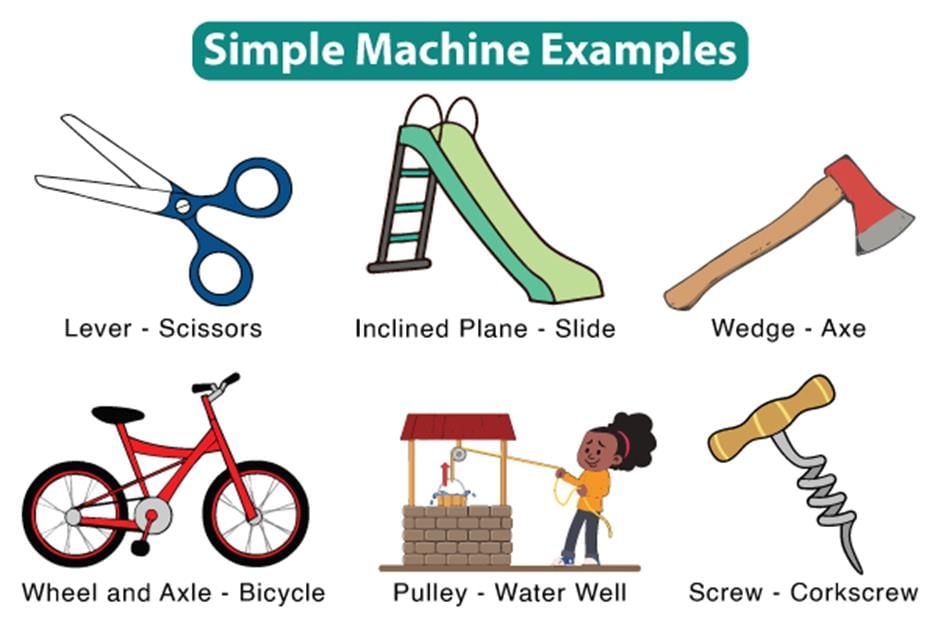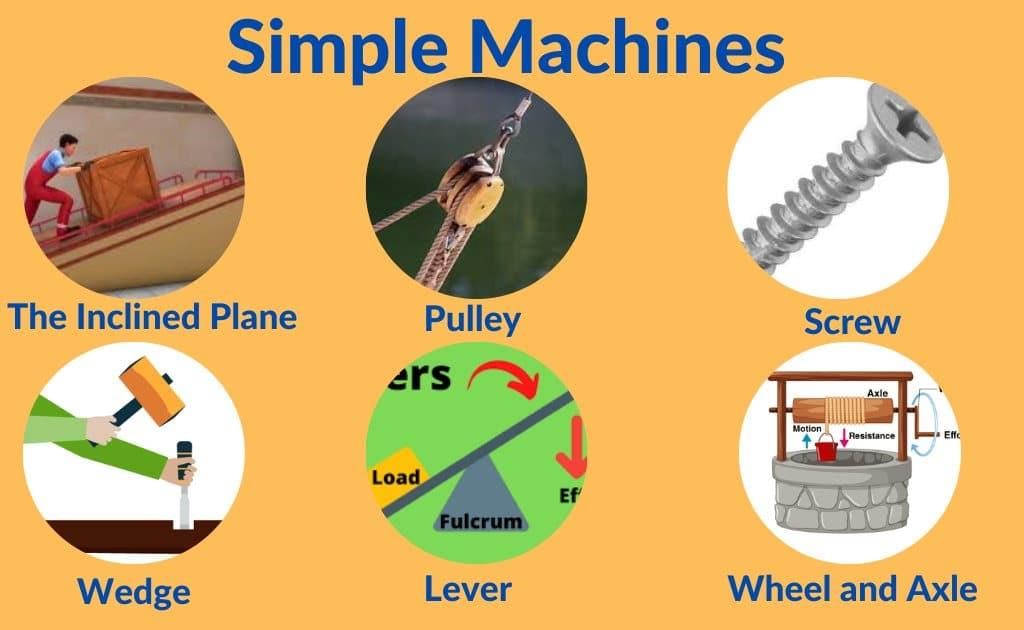Simple Machines Chapter Notes | Science Class 5 ICSE PDF Download
| Table of contents |

|
| Introduction |

|
| Need for Machines |

|
| Types of Simple Machines |

|
| Points To Remember |

|
| Glossary |

|
Introduction
In this chapter, we will learn about simple machines, which are tools that help us do our work faster and easier. Simple machines reduce the effort and time we need to complete tasks in our daily lives. There are two types of machines: simple machines, like a lever or pulley, and complex machines, like a scooter or washing machine. This chapter explains what simple machines are, why we need them, and the different types, such as levers, inclined planes, pulleys, wheels and axles, screws, and wedges. We will also explore how they work and their uses in everyday life.

Need for Machines
- Work happens when a force moves an object from one place to another.
- Machines make work easier by lowering the amount of force needed to move an object.
- Machines also save time by helping us finish tasks faster.
- For example, a can opener helps open a can of cold drink with less effort.
- Another example is a trolley, which helps carry heavy loads in a store easily.
- In these examples, the can opener and trolley are simple machines that reduce effort and time.
Types of Simple Machines

- There are many simple machines that help us in different ways.
- The most common simple machines are lever, inclined plane, pulley, wheel and axle, screw, and wedge.
- We will learn about each of these machines and how they help us.
Lever
- A lever is a long, stiff bar or rod that rests on a point called a fulcrum.
- It is used to lift heavy objects with less effort.
- For example, to move a big stone, a person needs a lot of force if they use their hands or a stick.
- But if a small stone is placed under the stick as a fulcrum, and force is applied at the other end, the big stone moves with less effort.
- In this example, the big stone is the load, the force applied is Effort, and the small stone is the fulcrum.
- The longer the lever or the closer the fulcrum is to the load, the easier it is to move the load.
- Examples of levers we use every day are hammers, tongs, scissors, pliers, and nail clippers.
Classes of Levers
Levers are divided into three classes based on the positions of the fulcrum, load, and effort:
- Class one levers: The fulcrum is between the effort and the load. Examples of class one levers are scissors, pliers, and see-saws.
- Class two levers: The load is between the fulcrum and the effort. Examples of class two levers are bottle openers, nutcrackers, and wheelbarrows.
- Class three levers: The effort is between the fulcrum and the load. Examples of class three levers are tongs and fishing rods.
Inclined Plane
- An inclined plane is a slanting or sloping surface that connects a lower level to a higher level.
- It helps move heavy objects to a height with less effort.
- For example, it takes less effort to push a load in a trolley up a slope than to lift the load straight up stairs.
- Examples of inclined planes are children’s slides in playgrounds, ramps for wheelchairs, and sloping roads.
Pulley
- A pulley is a simple machine made with a rope or chain wrapped around a wheel.
- It changes the direction of force to make lifting things to a height easier.
- Pulleys are used in situations like drawing water from a well, raising a flag on a flagpole, and loading goods.
- There are two types of pulleys: fixed pulley and movable pulley.
- Fixed pulley:The pulley is fixed to a point and does not move.
- Fixed pulleys change the direction of force but need a large effort to move an object.
- Examples of fixed pulleys are wells and flagpoles.
- Movable pulley: The pulley moves along with the load.
- Movable pulleys reduce the effort needed to pull the load.
- Examples of movable pulleys are cranes, ropeways, and block and tackle pulleys in sailing boats.
Wheel and Axle
- A wheel and axle is a simple machine where a large wheel rotates around a smaller centre called the axle.
- The wheel and axle must move together to work as a simple machine.
- Effort applied to the wheel helps turn the axle, and effort applied to the axle helps turn the wheel.
- This arrangement is used for lifting and moving loads.
- Examples of wheel and axle are tyres of cars or trucks, screwdrivers, steering wheels, and door knobs.
Screw
- A screw is an inclined plane wrapped around a rod in a spiral shape.
- It is used to hold things together or lift materials.
- Screws interlock two things so they cannot be separated easily.
- Screws are also used for lifting things, like in a jack.
Wedge
- A wedge is a triangular-shaped simple machine with slanting edges that meet to form a sharp edge at one end.
- It can be made of metal, wood, or stone.
- The sharp edge is used to break or cut materials by applying force with a handle.
- Examples of wedges are axes, knives, and our teeth.
Points To Remember
- A machine is a device or tool that helps us do work easily by reducing the time and the amount of force.
- Machines are of two types—simple (like lever and pulley) and complex (like scooter and washing machine).
- There is a wide range of simple machines, with the most common ones being lever, inclined plane, pulley, wheel and axle, screw, and wedge.
Glossary
- Machine: A device or tool that helps us do work easily by reducing the time and the amount of force.
- Lever: A simple machine with a rigid bar or rod that rests on a support and is used to lift heavy weights with minimum effort.
- Inclined plane: A sloping or slanting surface that connects a lower level to a higher level.
- Pulley: A simple machine made with a rope or chain wrapped around a wheel.
- Wheel and axle: A simple machine where a large wheel rotates around the centre called the axle.
- Screw: An inclined plane wrapped around a rod in a spiral shape.
- Wedge: A triangular-shaped simple machine with slanting edges that meet to form a sharp edge at one end.
|
48 docs|11 tests
|
FAQs on Simple Machines Chapter Notes - Science Class 5 ICSE
| 1. What are simple machines and why are they important? |  |
| 2. What are the different types of simple machines? |  |
| 3. How do simple machines make work easier? |  |
| 4. What are some real-life examples of simple machines? |  |
| 5. What key points should students remember about simple machines? |  |















